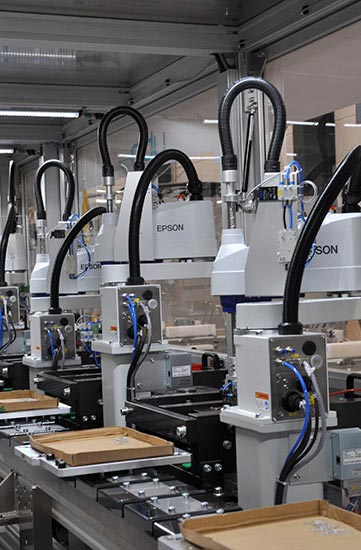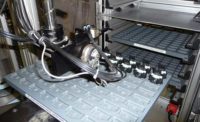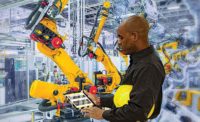Modern cars contain up to 20 percent plastic. This makes them lighter and more energy-efficient. Headlights, bumpers, mirrors are the most obvious polymer components on the outside. In the interior, there is hardly any part that is not made of plastic.
Many more plastic components are hidden from sight, such as injection-molded plug-in connections for sensors, control signals, and power transmission. These small, but significant, parts require a good deal of engineering. The connectors are exposed to a lot of stress, such as changing temperatures and vibrations, but must nevertheless be secure and reliable.
When assembling these components, one thing counts above all else: absolute precision. For machine builder UBH Mechanical Engineering GmbH, maximum precision is no problem. Based in Ebermannsdorf, Germany, some 47 miles east of Nuremberg in Bavaria, UBH has been building high-speed, high-precision automated assembly systems for nearly two decades.
UBH Mechanical Engineering began as an offshoot of UBH Software and Engineering, which has been creating software for intralogistics and automation for more than 35 years. With the know-how gained over many years, the company launched UBH Mechanical Engineering in 2005. Expanding from software development for automation to designing and building complex automation assembly systems has paid off. Today, UBH is known for its innovative and creative automation systems.
“We always take the path from the product to the system, never the path from the system to the product,” explains Siegfried Schwarzer, managing director at UBH Mechanical Engineering. “This makes us particularly solution-oriented—detached from a fixed basic system. This means we can integrate different systems into one plant. This conceptual flexibility makes us very successful.”
Precision Reminiscent of Ballet
Recently, UBH Mechanical Engineering designed and built a multistation automated assembly system to produce 2.6 million injection-molded connectors for the automotive industry each year. The workhorses of the system are 12 SCARA robots from Epson, which deliver high speed with optimum accuracy.
Until about five years ago, UBH primarily relied on linear axis systems, designed in-house, for pick-and-place tasks in automated assembly systems. However, those devices could not meet the speed, accuracy and flexibility requirements of the connector assembly application.
In the connector assembly machine, the SCARAs take on a wide variety of tasks. Right at the beginning of the process, seven SCARAs move in a row with an elegant lightness and dynamic precision reminiscent of modern ballet. Their job is clearly defined: They grab metal pins coming from seven feed stations and insert them into workpiece carriers at various positions. Precisely positioned, the metal pins are then over-molded with plastic in a shape that is both stable and functional.

A dozen SCARA robots are the workhorses of this automated assembly system, which produces 2.6 million injection-molded electrical connectors annually. Photo courtesy UBH Mechanical Engineering GmbH
Five additional SCARA robots then pick and place the freshly molded connectors in and out of various processing stations with special tooling. The most important stations are the application of a Data Matrix code by a laser; an inspection station for checking pin length; and an additional machine vision inspection. Finally, the connector elements are securely packed in trays.
A special feature of the new system is the dynamic logistics using robot technology. “We don’t guide the component through the plant in a classic fixed cycle, but rather we do it flexibly and dynamically,” says Schwarzer. “The robot systems overlap and interlock, such as in the inspection station or when printing by the laser.”
For UBH Mechanical Engineering, it was the first time that it had also used SCARA robots to assemble electrical contacts in a system. “Different positions can be approached with high precision and sometimes even several contacts can be inserted at once,” explains Schwarzer.
In addition to speed, flexibility and precision, the high degree of reusability for changing tasks and components also works in favor of the robots. “Robots enable us to react to position changes much faster than if we were working with linear axes. We have greater flexibility if the component changes or additional work steps are added,” Schwarzer points out.
In addition to the innovative and reliable robot technology itself, Schwarzer appreciates Epson’s good cooperation and support with robotics know-how. “When we took our first steps in the field of robotics five years ago, we received excellent support from Epson’s field service and specialist departments,” he recalls. “We had to learn to rethink away from linear movements to dynamic ones. Epson really helped us a lot with that.”
What UBH Mechanical Engineering particularly appreciates about Epson’s product portfolio is that it is so broadly diversified. With more than 300 models of SCARA robots alone, Epson enables UBH to customize systems for a multitude of applications.
For more information on assembly robots, visit https://epson.com.
ASSEMBLY ONLINE
For more information on robots, read these articles:
Robots Assemble Medical Device on Rotary Indexers
What's New with Robotic Soldering?
SCARA Robots Excel at Assembly




